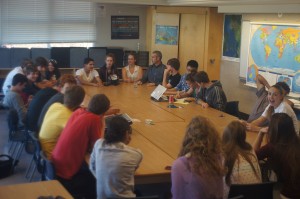Pathways to Possibility

Originally appears in the Winter 2013-2014 issue
“What’s the point ?”
This was a statement made by one of my brightest grade 11 students at the beginning of a current events unit on increasing human consumption and declining resources. This question resonated with me for days afterwards. Apathetic comments from 15 year-old boys are nothing new, but this particular statement was different. The more I thought about it, the more I realized that this student, like so many others, was simply bewildered by the gloom and doom surrounding our present ecological state. When I spoke to the class a few days later, they confirmed my realization. While it was obvious they were concerned about receding ice caps and increasing levels of greenhouse gases in our atmosphere, many of them appeared overwhelmed by the thought and scale of so many seemingly unsolvable problems. They were not indifferent to environmental degradation. They were afraid.
There is little question that we have to educate students about the world’s most pressing problems, especially at a time when we face a convergence of unprecedented ecological, economic and social challenges. However, it can be argued that preparing students to be aware of their environment and act on its behalf depends on how we present the challenges. Terrible news catches our attention, but it is not especially good at changing our minds or motivating us. In fact, it might do the exact opposite. The way to enact positive change is to show what is possible.
Through my teaching experiences and interaction with other educators in British Columbia, I came to the realization that while we have certain courses that touch on issues of sustainability (Social Studies, Geography, Earth Science, Biology, Chemistry, Civics, and Law etc.), we do not have a comprehensive course that seeks to educate students on the three interdependent pillars of sustainability: environmental protection, economic prosperity, and social well-being/equity.
Since the world has accumulated a growing number of unresolved problems over the past few decades by ignoring the links between these three areas, it has become clear to me that we need curriculum that connects the dots and prompts students to look ahead toward a more positive vision.
To view the photo-rich magazine version, click here.
If you are not already a subscriber, please subscribe to read the full article
Graeme Mitchell is a teacher at Claremont Secondary in Saanich, B.C. and co-founder of the Institute of Global Solutions. He is set to start his Doctoral Studies in the spring. He wants to thank the following: his school’s ever-supportive administration, his forward-thinking School District and especially his IGS colleagues Mark Neufeld and Dave Gardner for their inspiration, dedication, and professionalism.
Leave a Reply
You must be logged in to post a comment.





